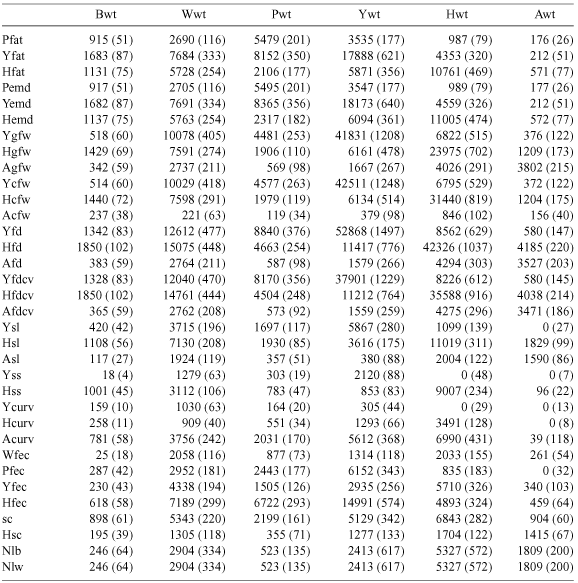Genetic parameters for bodyweight, wool, and disease resistance and reproduction traits in Merino sheep. 2. Genetic relationships between bodyweight traits and other traits
A. E. Huisman A B and D. J. Brown A B CA Animal Genetics and Breeding Unit1, University of New England, Armidale, NSW 2351, Australia.
B Current Address: Hypor, 5830 AA Boxmeer, The Netherlands.
C Corresponding author. Email: dbrown2@une.edu.au
Australian Journal of Experimental Agriculture 48(9) 1186-1193 https://doi.org/10.1071/EA08120
Submitted: 10 April 2008 Accepted: 2 May 2008 Published: 7 August 2008
Abstract
The Australian Merino is the predominant genetic resource for both the prime lamb and sheep meat industries of Australia. There are very few studies that provide good information on the relationships between wool and non-wool traits. The objective of this paper was to describe genetic relationships within bodyweight traits and between bodyweight and other traits recorded in Merino sheep. The genetic correlation between bodyweight, fleece weight and fibre diameter was positive (0.1 to 0.2). While fibre diameter coefficient of variation, staple length, staple strength, mean fibre curvature, and faecal egg count were not correlated with bodyweight. Scrotal circumference (0.4), number of lambs born (0.1), and number of lambs weaned (0.1) were positively correlated with bodyweight. Results indicate that selection for an increase in bodyweight will have a positive effect on eye muscle depth, fleece weight, and reproduction traits, while selection for an increase in bodyweight will have a negative effect on fibre diameter and fibre diameter coefficient of variation.
Acknowledgements
This research was funded by Meat and Livestock Australia (MLA), UNE and NSW Department of Primary Industries. The authors would like to thank the Merino breeders and accredited Lambplan scanners who collected the pedigree and performance data used in this study. The work of Stephen Field, the MGS database manager, and that of Bronwyn Clarke, who managed the Merino Validation Project, is acknowledged.
Analla M, Serradilla JM
(1998) Estimation of correlations between ewe litter size and maternal effects on lamb weights in Merino sheep. Genetics, Selection, Evolution 30, 493–501.
| Crossref | GoogleScholarGoogle Scholar |

Brash LD,
Fogarty NM, Gilmour AR
(1994) Genetic parameters for Australian maternal and dual-purpose meatsheep breeds. II. Liveweight, wool and reproduction in Corriedale sheep. Australian Journal of Agricultural Research 45, 469–480.
| Crossref | GoogleScholarGoogle Scholar |

Brown DJ,
Ball A,
Mortimer R, Oppenheimer M
(2002) Incorporating subjectively assessed sheep and wool traits into genetic evaluations for Merino sheep 2: Phenotypic and genetic correlations. Wool Technology and Sheep Breeding 50, 378–382.

Brown DJ,
Huisman AE,
Swan AA,
Graser H-U,
Woolaston RR,
Ball AJ,
Atkins KD, Banks RB
(2007) Genetic evaluation for the Australian sheep industry. Proceedings of the Association for the Advancement of Animal Breeding and Genetics 17, 187–194.

Clarke BE,
Brown DJ, Ball AJ
(2003) Preliminary genetic parameters for live weight and ultrasound scan traits in Merinos. Proceedings of the Association for the Advancement of Animal Breeding and Genetics 15, 326–330.

Eady SJ,
Woolaston RR,
Lewer RP,
Raadsma HW, Swan AA
(1998) Resistance to nematode parasites in Merino sheep: correlation with production traits. Australian Journal of Agricultural Research 49, 1201–1211.
| Crossref | GoogleScholarGoogle Scholar |

Fogarty NM
(1995) Genetic parameters for live weight, fat and muscle measurements, wool production and reproduction in sheep: a review. Animal Breeding Abstracts 63, 101–143.

Fossceco SL, Notter DR
(1995) Heritabilities and genetic correlations of body weight, testis growth and ewe lamb reproductive traits in crossbred sheep. Animal Science (Penicuik, Scotland) 60, 185–195.

Greeff JC, Karlsson LJE
(1999) Will selection for decrease faecal worm egg count result in an increase in scouring? Proceedings of the Association for the Advancement of Animal Breeding and Genetics 13, 508–511.

Huisman AE,
Brown DJ,
Ball AJ, Graser H-U
(2008) Genetic parameters for weight, wool, and disease resistance and reproduction traits in Merino sheep. 1. Description of traits, model comparison, variances and their ratios. Australian Journal of Experimental Agriculture 48, 1177–1185.

Ingham VM,
Ponzoni RW,
Gilmour AR, Pitchford WS
(2003) Genetic parameters for weight, fat and eye muscle depth in South Australian Merino sheep. Proceedings of the Association for the Advancement of Animal Breeding and Genetics 15, 322–325.

Lewer RP,
Woolaston RR, Howe RR
(1994) Studies on Western Australian Merino Sheep. II. Genetic and Phenotypic parameter estimates for objectively measured traits on ram and ewe hoggets using different model types. Australian Journal of Agricultural Research 45, 829–840.
| Crossref | GoogleScholarGoogle Scholar |

Purvis IW, Swan AA
(1997) Can follicle density be used to enhance the rate of genetic improvement in Merino flocks? Proceedings of the Association for the Advancement of Animal Breeding and Genetics 12, 512–515.

Simm G,
Lewis RM,
Grundy B, Dingwall WS
(2002) Responses to selection for lean growth in sheep. Animal Science (Penicuik, Scotland) 74, 39–50.

Swan AA,
Lax J, Purvis IW
(1995) Genetic variation in objectively measured wool traits in CSIRO’s fine wool flock. Proceedings of the Association for the Advancement of Animal Breeding and Genetics 11, 516–520.

Vaez Torshizi R,
Nicholas FW, Raadsma HW
(1996) REML estimates of variance and covariance components for production traits in Australian Merino sheep using an animal model 1. Body weight from birth to 22 months. Australian Journal of Agricultural Research 47, 1235–1249.
| Crossref | GoogleScholarGoogle Scholar |

Wuliji T,
Dodds KG,
Land JTJ,
Andrews RN, Turner PR
(2001) Selection for ultrafine Merino sheep in New Zealand: heritability, phenotypic and genetic correlations of live weight, fleece weight and wool characteristics in yearlings. Animal Science (Penicuik, Scotland) 72, 241–250.
Manuscript received 10 April 2008, accepted 2 May 2008
.

1 AGBU is a joint venture of NSW Department of Primary Industries and the University of New England.

|


